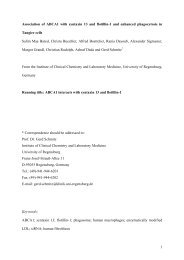SUNDAY, DECEMBER 4- Late Abstracts 1 - Molecular Biology of the ...
SUNDAY, DECEMBER 4- Late Abstracts 1 - Molecular Biology of the ...
SUNDAY, DECEMBER 4- Late Abstracts 1 - Molecular Biology of the ...
You also want an ePaper? Increase the reach of your titles
YUMPU automatically turns print PDFs into web optimized ePapers that Google loves.
<strong>SUNDAY</strong><br />
1972<br />
Proteomic Characterization <strong>of</strong> <strong>the</strong> Binding Partners <strong>of</strong> Dopamine Transporter (DAT) and<br />
Functional DAT Mutants.<br />
S. M. Moore 1,2 , A. Rao 2 , A. Sorkin 1 , C. C. Wu 1 ; 1 Cell <strong>Biology</strong> and Physiology, University <strong>of</strong><br />
Pittsburgh, Pittsburgh, PA, 2 Pharmacology, University <strong>of</strong> Colorado Anschutz Medical Campus,<br />
Aurora, CO<br />
Dopamine transporter (DAT) is a 12-transmembrane domain, integral membrane protein that<br />
acts to terminate <strong>the</strong> synaptic transmission <strong>of</strong> <strong>the</strong> neurotransmitter dopamine. DAT is normally<br />
expressed primarily on <strong>the</strong> plasma membrane <strong>of</strong> <strong>the</strong> cell and is internalized through clathrinmediated<br />
endocytosis. It has been shown that with N-terminal deletion, DAT undergoes<br />
increased internalization through augmented levels <strong>of</strong> endocytosis. Conversely, a C-terminal<br />
deletion variant <strong>of</strong> DAT has been shown to reside primarily in <strong>the</strong> endoplasmic reticulum, with<br />
unknown endocytic effects. The main objective <strong>of</strong> this project is to utilize mass spectrometry<br />
pr<strong>of</strong>iling methods to analyze <strong>the</strong> binding partners <strong>of</strong> <strong>the</strong>se different DAT constructs in order to<br />
increase <strong>the</strong> understanding <strong>of</strong> DAT trafficking and endocytosis. Initial studies in mice expressing<br />
a full-length hemagglutinin (HA)-tagged DAT construct combined immunoprecipitation (IP) using<br />
an HA antibody with pr<strong>of</strong>iling mass spectrometry. These studies resulted in <strong>the</strong> identification <strong>of</strong> a<br />
variety <strong>of</strong> potential DAT binding partners. Some <strong>of</strong> <strong>the</strong> identified proteins were previously known<br />
to be DAT binding partners, o<strong>the</strong>rs were known to be involved in endocytosis, and still o<strong>the</strong>rs<br />
were known to be involved in synaptic transmission. These mouse studies inspired fur<strong>the</strong>r<br />
proteomic studies in cell lines containing <strong>the</strong> aforementioned DAT constructs, due to <strong>the</strong><br />
identification <strong>of</strong> endocytic proteins in <strong>the</strong> mouse studies along with <strong>the</strong> difference in endocytic<br />
patterns in <strong>the</strong> DAT construct containing cell lines. Full length (FL), N-terminally deleted (ΔN),<br />
and C-terminally deleted (ΔC) DAT constructs, dually tagged with YFP and HA, were stably<br />
expressed in porcine aortic endo<strong>the</strong>lial (PAE) cells. These constructs <strong>the</strong>n underwent IP using<br />
ei<strong>the</strong>r HA or GFP antibodies. After IP <strong>the</strong> samples were digested with trypsin and analyzed on<br />
ei<strong>the</strong>r an LTQ linear ion trap mass spectrometer, for pr<strong>of</strong>iling experiments, or a TSQ Vantage<br />
triple quadrupole mass spectrometer, for quantitative experiments. In <strong>the</strong>se cell studies, several<br />
proteins were identified that were present in all three samples while o<strong>the</strong>rs were expressed<br />
differentially between <strong>the</strong> samples when compared to <strong>the</strong> parental PAE cell line. Proteins<br />
present in all samples included ubiquitin, calmodulin, and alpha-tubulin. Differentially expressed<br />
proteins included clathrin heavy chain, Rho-GEF 12, and AP2 alpha-1 subunit, among a variety<br />
<strong>of</strong> o<strong>the</strong>rs. This differential expression indicates that <strong>the</strong> endocytic changes that occur with <strong>the</strong>se<br />
deletion mutations are accompanied by changes in <strong>the</strong> proteins that associate with DAT.<br />
1973<br />
Cell adhesion and survival requires integrin rapid recycling.<br />
N. Waxmonsky 1 , S. Conner 1 ; 1 University <strong>of</strong> Minnesota, Minneapolis, MN<br />
Integrins are transmembrane heterodimers composed <strong>of</strong> an α and a β subunit that mediate<br />
attachment between <strong>the</strong> cell and its environment, which is a requirement for cell survival in<br />
many cell types. Cells maintain adhesion by trafficking integrins to <strong>the</strong> cell surface through<br />
endosomal sorting pathways; however, <strong>the</strong> molecular mechanisms governing this process are<br />
undefined. We hypo<strong>the</strong>sized that integrin recycling through <strong>the</strong> endosomal compartment is<br />
important for maintenance <strong>of</strong> cell adhesion. In order to test this, we depleted HeLa cells <strong>of</strong><br />
factors with known roles in long- and short-loop recycling. Depletion <strong>of</strong> a long-loop recycling<br />
factor, EHD1 (Eps15 Homology Domain), did not lead to loss <strong>of</strong> adhesion. However, depletion<br />
<strong>of</strong> factors that have established roles at <strong>the</strong> early endosome, AAK1 (Adaptor-Associated Kinase<br />
1) and EHD3, led to cell rounding and an eventual loss <strong>of</strong> cell adhesion. Defects in integrin<br />
delivery to <strong>the</strong> cell surface disrupts formation <strong>of</strong> focal adhesion complexes. We investigated
















